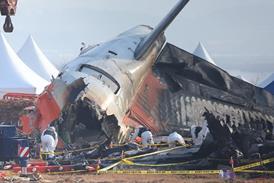Top causal factors of helicopter accidents in Europe are pilot judgement and actions and shortcomings in the operator's safety culture and management.
These are some of the many findings in a detailed analysis of 311 helicopter accident reports in Europe between 2000 and 2005 released this month at the International Helicopter Safety Team's meeting in Cascais, Portugal.
The analysis, by the IHST's European branch - the European Helicopter Safety Team (EHEST) - reveals that there is as yet no real sign of progress towards the IHST's ultimate objective of an 80% reduction in helicopter accidents by 2016.
However, although the IHST has been in existence for five years, the first of the tools with which it hopes to influence safety performance has only just been developed and been made available to operators. This time lag is inevitable because the team building strategy based on strict adherence to hard data, and it has taken the IHST's regional units this long to mine the data buried in five years' worth of official accident reports.
 |
|---|
In the EHEST's report, the European Helicopter Safety Implementation Team has - for the first time - made initial "intervention recommendations" to overcome the system weaknesses that cause most of the accidents. It has also announced that it has set up three specialist teams to identify ways to optimise operations and safety management systems, training, and regulation, according to the needs indicated by the analysis of the 311 accidents in the 2000-05 period.
Since 2005 no-one seems to have devised any new kinds of helicopter accident. All the regional safety teams note that not only have accident numbers remained the same, the causes keep on repeating. As the head of the Helicopter Association International Matt Zuccaro remarked: "Same old accidents in the same old machines."
EHEST found that topping the list of causal factors for European helicopter accidents is "pilot judgement and actions". This, like all the other factors, tallies almost perfectly with experience in the USA, Canada, India and several other regions. The top five factors may appear in a slightly different order, but the "standard problem statements" (as EHEST calls them) are almost always the same.
Number two on the EHEST list is "safety culture/management". Third comes "ground duties", which encompasses flight and mission planning - an area every agency identifies as seriously lacking.
 |
|---|
Fourth are "data issues", which is not really a causal factor, but an admission that most helicopter accident reports do not supply all the details they should have been able to provide if the report were to be truly useful in future accident prevention, which is a system failure in its own right.
Fifth comes lack of pilot situational awareness, closely followed by mission risk, and regulatory inadequacies.
Aircraft part or systems failure and aircraft design feature well down the list, outside of the top five, so the hoary old belief that the inherent unreliability of helicopters is the main cause of crashes is simply not borne out by the data. In short, the data shows it is the people, not the machines, that cause the crashes.
The implementation team's "intervention recommendations" are derived from hard data about what happened and why. The organisation believes these are the actions which, if applied, would deliver the target 80% reduction in helicopter accident rates by 2016. The generic categories that need attention are:
- Operations and safety management/culture
- Training/instruction
- Regulatory standards and guidelines.
EHEST has concluded that the average helicopter operator does not take mission preparation, risk analysis, and the creation of sensible standard operating procedures sufficiently seriously. Moreover, management behavioural traits tend to be repeated by individual pilots.
At Cascais it was clear what is keeping the IHST officials awake at night: the awareness that now they know for a fact what needs to be done, they are going to have a real problem getting the message out to the small operators that carry out 80-90% of helicopter operations in most countries. The small operators were not at Cascais, and they will not like the message - it is not flattering.
Source: Flight International























